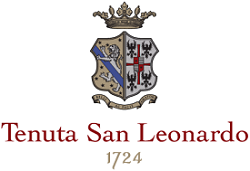Country:
 Italy Region: Trentino-Alto Adige
Italy Region: Trentino-Alto Adige
Type: Red Style: Dry
Drinking: 2019 - 2026
 50% Cabernet Sauvignon, 40% Merlot, 10% Carmenère Terre, a Bordeaux blend like San Leonardo and from the same terroir, follows in the footsteps of its “elder brother,” here with remarkable crispness and enviable balance. The grapes are sourced from the youngest estate vineyards, which yield a wine with a lighter structure, lively drinkability, and a refined pleasurableness that gives it a definite elegance. Terre di San Leonardo’s roundedness and harmony are finally crowned by a six-month bottle-ageing before release.
50% Cabernet Sauvignon, 40% Merlot, 10% Carmenère Terre, a Bordeaux blend like San Leonardo and from the same terroir, follows in the footsteps of its “elder brother,” here with remarkable crispness and enviable balance. The grapes are sourced from the youngest estate vineyards, which yield a wine with a lighter structure, lively drinkability, and a refined pleasurableness that gives it a definite elegance. Terre di San Leonardo’s roundedness and harmony are finally crowned by a six-month bottle-ageing before release.

Tenuta San Leonardo in Trentino has been home to the Guerrieri Gonzaga family for over three hundred years, but it is only since the second half of the twentieth century, when Marchese Carlo took over, that this estate began to take wine production seriously. Following a spell working at Tenuta San Guido with the creator of Sassicaia, Mario Incisa della Rocchetta, he was inspired to see if the clay-limestone soils of his family estate could yield similar results to those achieved by his mentor. In 1978 the first Cabernet Sauvignon vines joined the Merlot and Carmenère that had long been planted, and in 1982 the first vintage of the flagship San Leonardo was produced. The wine has changed very little since then. The estate covers an overall area of 300 hectares, of which the vineyards, planted to red grapes beginning at an elevation of 150 metres, amount to 30 hectares. Merlot is planted in pebble-rich soils that were once the bed of a tributary of the Adige, while Cabernet Sauvignon and the old vineyards of Carmenère are in predominantly sandy soils. All are well-drained, low-fertility soils that yield wines with truly unusual levels of anthocyanins, and not just for the Trentino. In 2015, San Leonardo launched a project of conversion to organic viticulture, which concluded successfully in late 2018 with the award of official certification. In the same year, the BWA Friends of Biodiversity organisation certified San Leonardo as a Friend of Biodiversity, testifying to San Leonardo ́s deep commitment to preserving the character of its growing area. Recent vintages display the same timeless elegance and subtlety as the first, traits that are echoed through the rest of the range, and that have helped secure San Leonardo’s place in the pantheon of great Italian wineries.
- Cabernet Sauvignon
The most famous red wine grape in the world and one of the most widely planted.
It is adaptable to a wide range of soils, although it performs particularly well on well-drained, low-fertile soils. It has small, dusty, black-blue berries with thick skins that produce deeply coloured, full-bodied wines with notable tannins. Its spiritual home is the Médoc and Graves regions of Bordeaux where it thrives on the well-drained gravel-rich soils producing tannic wines with piercing blackcurrant fruits that develop complex cedarwood and cigar box nuances when fully mature.
The grape is widely planted in California where Cabernet Sauvignon based wines are distinguished by their rich mixture of cassis, mint, eucalyptus and vanilla oak. It is planted across Australia and with particular success in Coonawarra where it is suited to the famed Terra Rossa soil. In Italy barrique aged Cabernet Sauvignon is a key component in Super Tuscans such as Tignanello and Sassicaia, either on its own or as part of a blend with Sangiovese - Carmenérè
No Information Currently Available!
- Merlot
The most widely planted grape in Bordeaux and a grape that has been on a relentless expansion drive throughout the world in the last decade. Merlot is adaptable to most soils and is relatively simple to cultivate. It is a vigorous naturally high yielding grape that requires savage pruning - over-cropped Merlot-based wines are dilute and bland. It is also vital to pick at optimum ripeness as Merlot can quickly lose its varietal characteristics if harvested overripe.
In St.Emilion and Pomerol it withstands the moist clay rich soils far better than Cabernet grapes, and at it best produces opulently rich, plummy clarets with succulent fruitcake-like nuances. Le Pin, Pétrus and Clinet are examples of hedonistically rich Merlot wines at their very best. It also plays a key supporting role in filling out the middle palate of the Cabernet-dominated wines of the Médoc and Graves.
Merlot is now grown in virtually all wine growing countries and is particularly successful in California, Chile and Northern Italy.
| Who | Score |
Start |
End |
Notes |
|---|---|---|---|---|
| Eric Guido Vinous.com Nov 2020 |
91/100 | 2020 | 2026 | The 2016 Terre di San Leonardo Rosso is an excellent introduction to the producer and their style. The wine is a blend of 50% Cabernet Sauvignon, 40% Merlot and 10% Carmenère from younger vines, yet the same terroir of the flagship San Leonardo. The bigger difference here is in the composition, with Merlot taking a front seat to Carmenère, and in the aging, using a blend of 80% concrete and 20% French oak for a shorter period of time. That said, the Terre di San Leonardo is intended to be the fresher and more immediate wine of the house. Crushed black cherries, wild, peppery herbs, crushed stone and hints of animal musk can be found in the glass. It trades power for tension, displaying a mix of tart woodland red and black berry fruits, complemented by zesty acids and minerals with just a hint of sweet spice. Its structure is present yet doesn’t overwhelm. |